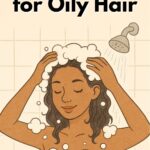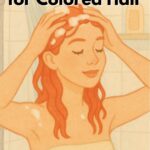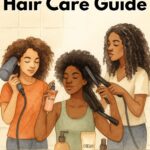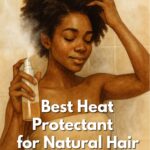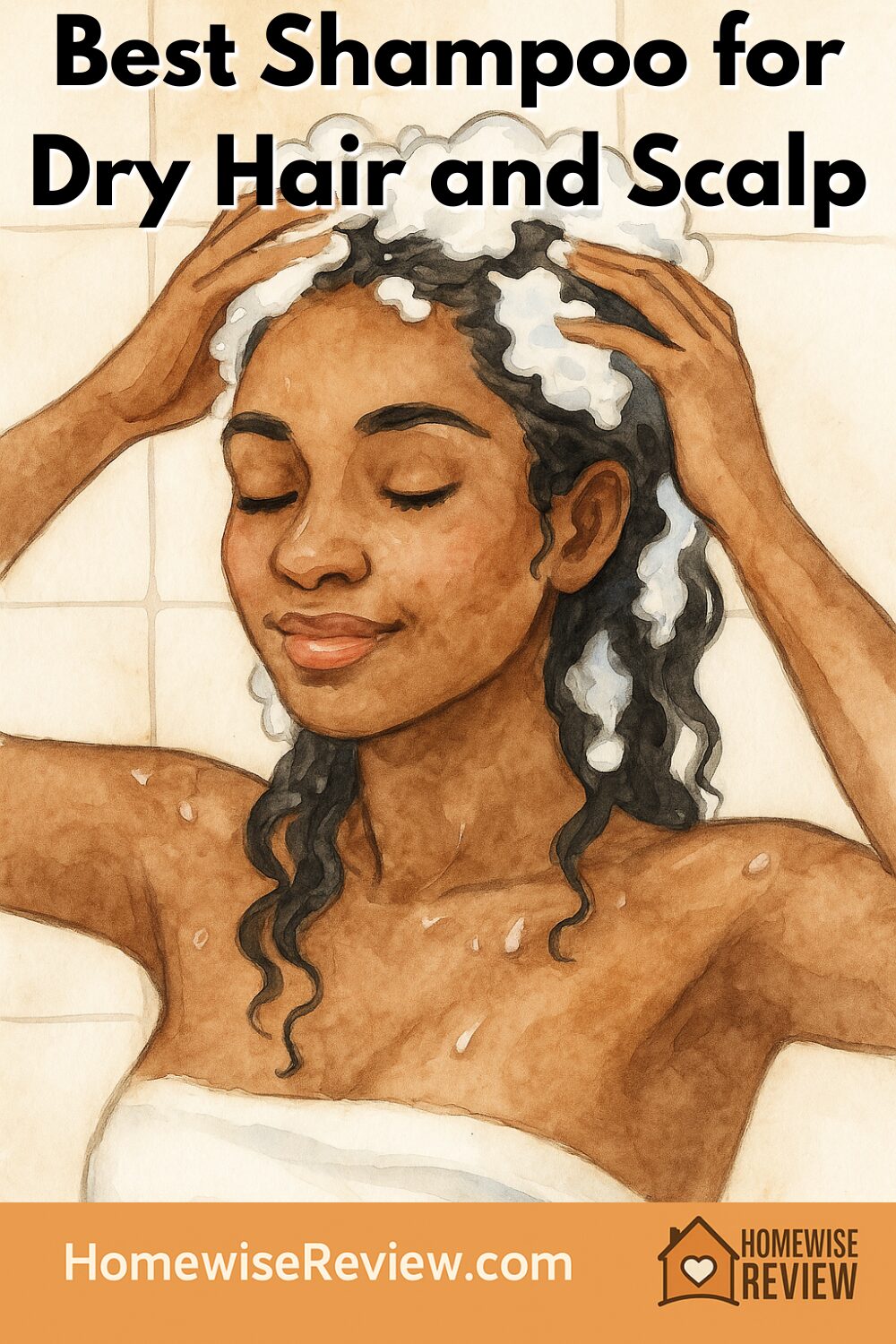
Straw-like lengths, tight itchy scalp, and flyaways that won’t quit? You’re not alone. In this guide we round up the best shampoo for dry hair and scalp and explain how to build a routine that restores moisture without leaving roots flat or greasy. You’ll find three excellent options at different price points, what ingredients actually help, what to avoid, and quick fixes when “dryness” is really dandruff or irritation.
Top picks at a glance
- Best overall (salon): Kérastase Nutritive Bain Satin Riche – luxurious cleanse that softens brittle ends and comforts a tight scalp without residue.
- Best everyday (color-safe, sulfate-free): Moroccanoil Hydrating Shampoo – gentle lather; glycerin + argan oil leave hair smooth and easy to detangle.
- Best for dry, sensitive scalp (budget): Aveeno Scalp Soothing Oat Milk Blend Shampoo – colloidal oatmeal + glycerin calm itch and dryness while staying light.
How we choose: We analyze INCI lists for humectants and mild surfactants, check brand transparency, dermatologist guidance, third-party lab tests (when available), and hundreds of verified owner reviews. We don’t claim hands-on testing of every item; our goal is to help you choose confidently from credible options.
Quick comparison
| Product | Best for | Key hydrators & surfactants | Sulfate-free | Notes |
|---|---|---|---|---|
| Kérastase Nutritive Bain Satin Riche | Very dry hair & tight scalp that still wants volume | Glycerin, plant proteins, niacinamide; gentle surfactants (coco-betaine, isethionates) | Yes | Cream-gel lather, classic salon scent, pairs well with heat styling |
| Moroccanoil Hydrating Shampoo | Daily use on dry, color-treated hair | Glycerin, argan oil, algae, panthenol; mild sulfonate system | Yes | Color-safe, detangles well, rich lather without squeak |
| Aveeno Scalp Soothing Oat Milk Blend | Dry, sensitive scalp; kids & perfume-sensitive homes | Colloidal oatmeal, glycerin, oat extract; amphoteric surfactants | Yes | Lightly scented, budget friendly, very gentle |
We may earn a small referral fee if you buy through our links—at no extra cost to you.
Why these three?
1) Kérastase Nutritive Bain Satin Riche — Best overall
What it is: The Nutritive line was refreshed with niacinamide and plant-based proteins to support the scalp barrier and hair fiber. Bain Satin Riche is the most nourishing cleanser in the range.
What you’ll notice: A plush cream-gel that works into a fine lather, rinsing clean at the roots while leaving mid-lengths flexible and soft. Users commonly report fewer flyaways and less “pull” when brushing. Unlike heavy moisturizing shampoos, it doesn’t collapse volume.
Why it works: Glycerin pulls water in, niacinamide supports the scalp’s moisture barrier, and milder surfactants (e.g., coco-betaine, sodium cocoyl isethionate) cleanse without stripping.
Best for: Medium to coarse strands; very dry, heat- or color-stressed hair; anyone who wants a salon finish.
Good to know: Salon price; use a nickel-sized amount and focus on the scalp—let suds clean the lengths. Pair with a light conditioner if your roots flatten easily.
2) Moroccanoil Hydrating Shampoo — Best everyday, color-safe
What it is: A widely loved daily shampoo that’s sulfate-, phosphate-, and paraben-free. It’s built around glycerin, panthenol, and argan oil for slip and shine.
What you’ll notice: Rich but not squeaky lather, easier detangling in the shower, and a smooth lay-down after blow-drying. Color stay is excellent because the surfactant system is gentle.
Why it works: Humectants (glycerin/panthenol) hydrate, arginine/alginate support the fiber, and argan oil adds emollience without weight when used in a rinse-off format.
Best for: Fine-to-medium, color-treated or heat-styled hair that feels dry and frizzy; everyday washing.
Good to know: Signature Moroccanoil fragrance; if you’re fragrance-sensitive, sniff first or choose Aveeno below.
3) Aveeno Scalp Soothing Oat Milk Blend — Best for dry, sensitive scalp (budget)
What it is: A very gentle, dermatologist-beloved formula featuring colloidal oatmeal, oat extract, and glycerin to relieve tight, uncomfortable scalp.
What you’ll notice: Reduced itch and less tautness after a few washes, with a clean but non-stripping feel at the roots. It leaves ends soft, especially when followed by a light conditioner.
Why it works: Oat’s beta-glucans calm reactivity; the surfactant mix is amphoteric (mild), so it won’t scrub away what little moisture your scalp has.
Best for: Sensitive skin households, kids, pregnancy/post-partum dryness, perfume aversion.
Good to know: Light scent; if your ends are very parched, pair with a richer conditioner or weekly mask.
How to pick a shampoo for dry hair and scalp
Look for:
- Humectants: glycerin, propanediol, sorbitol, aloe, hyaluronic acid.
- Barrier helpers: niacinamide, oat/colloidal oatmeal, panthenol, ceramide-like lipids.
- Mild surfactants: coco-betaine, isethionates, sulfosuccinates, amino-based surfactants.
- Light emollients: argan, jojoba, squalane; avoid heavy oils if your roots lie flat.
Avoid/limit:
- Frequent use of strong sulfates (SLS/SLES) if you’re already dry.
- High alcohol denat near the top of the INCI in leave-on products (okay in wash-off when low).
- Peppermint/menthol if your scalp is reactive; they can feel great but worsen dryness in some.
How often to wash: Most dry scalps do best at 2–4 shampoos/week. If you sweat or exercise, rinse with water and condition the ends between washes.
Routine that makes shampoos work harder
- Pre-rinse: Saturate hair & scalp with lukewarm water 60–90 seconds; it reduces the amount of shampoo needed.
- Scalp-first cleanse: Use a quarter-size amount; massage with fingertips (not nails) for 60 seconds. Let lather drift down lengths.
- Condition smartly: Apply only mid-lengths to ends unless your scalp is truly dry and flaking (then use a lightweight, scalp-safe conditioner sparingly).
- Weekly mask or oil-pre-wash: Once a week, apply a few drops of squalane or a ceramide mask to the last ⅔ of hair for 10–20 minutes before shampoo.
- Style protection: Use a heat protectant and keep tools under 400°F/200°C.
- Environmental help: A humidifier in winter can noticeably reduce static and scalp tightness.
When “dryness” is actually dandruff or eczema
Persistent flakes, redness, or itch may be seborrheic dermatitis or eczema. In that case, alternate your hydrating pick with a medicated shampoo 2–3×/week, then condition the lengths:
- Ketoconazole 1% (e.g., Nizoral A-D) – antifungal; leave on 5 minutes.
- Pyrithione zinc 1% – anti-yeast/anti-inflammatory (Head & Shoulders Dry Scalp Care is a gentler option).
- Selenium sulfide 1% – for stubborn flaking (can be stronger; watch color-treated hair).
See a dermatologist if symptoms persist >4 weeks.
Who should pick which?
- Fine hair, needs moisture but hates weight: Moroccanoil Hydrating.
- Very dry, heat or color stressed hair; tight scalp: Kérastase Bain Satin Riche.
- Sensitive, easily irritated scalp (including kids): Aveeno Oat Milk Blend.
- Curly/coily and parched: Use one of the above shampoos and add a weekly deep conditioner or co-wash on off days.
The bottom line
If you want one bottle that softens lengths and keeps roots fresh, Kérastase Nutritive Bain Satin Riche is the salon workhorse. For daily, color-safe moisture without collapse, Moroccanoil Hydrating Shampoo is the crowd-pleaser. If scalp sensitivity is your main battle, Aveeno’s Oat Milk Blend is the gentle (and affordable) fix. Pair your pick with a weekly mask and kinder heat habits, and “dry” starts to feel like “normal” again.
We may earn a small referral fee if you buy through our links—at no extra cost to you.
FAQs
Do I need to put conditioner on my scalp?
Generally no—keep conditioner from mid-lengths down. If your scalp is truly dry (not flaky), you can palm-rub a pea-size of a scalp-safe conditioner (oat/niacinamide, minimal oils) and rinse thoroughly.
Can I oil my scalp for dryness?
Light oils (squalane, jojoba) as a pre-shampoo can help; avoid leaving heavy oils on the scalp—they may trap flakes and feed Malassezia yeast in dandruff-prone folks.
Are shampoo bars good for dry hair?
Some are great, but many use soap-based systems with higher pH that can roughen hair. If you try a bar, look for syndet bars (SCI, isethionates) and follow with a conditioner.
Color-treated hair—will these strip dye?
All three picks are sulfate-free with gentle surfactants and are widely used on colored hair. Extend color life further with cooler water and weekly masks.
See Also:
If limp strands are your main struggle, explore our guide to the Best Shampoo for Fine Hair. For scalps that skew oily, our Best Conditioner for Oily Hair picks balance hydration without buildup—and when you need a fresh-start cleanse, don’t miss the Best Shampoo for Oily Hair roundup.

